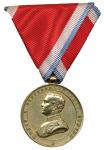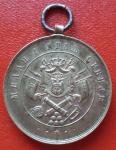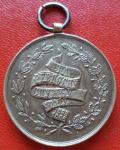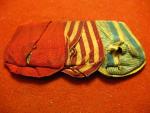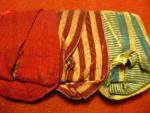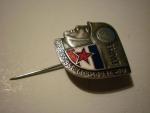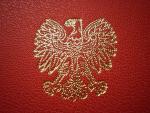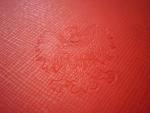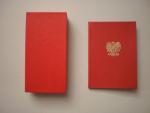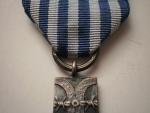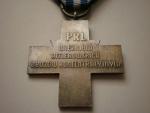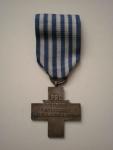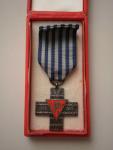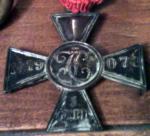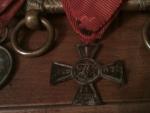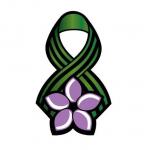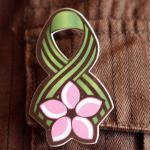-
Posts
3,629 -
Joined
-
Last visited
-
Days Won
1
Content Type
Profiles
Forums
Blogs
Gallery
Events
Store
Everything posted by paja
-
Serbia Serbia Kingdom medal Bar on Ebay
paja replied to Emanuel's topic in Southern European & Balkan States
Golden bravery medal (but 1877-78, not that rare as the 1885-86 medal), Barac & Pervan, December 2012, 350 euros. http://gmic.co.uk/uploads/monthly_01_2013/post-7937-0-61426100-1358118009.jpghttp://gmic.co.uk/uploads/monthly_01_2013/post-7937-0-32429100-1358118028.jpg -
Serbia Serbia Kingdom medal Bar on Ebay
paja replied to Emanuel's topic in Southern European & Balkan States
Medal for diligent service in war (1885-86), again ebay, 700$. http://gmic.co.uk/uploads/monthly_01_2013/post-7937-0-81352300-1358117374.jpghttp://gmic.co.uk/uploads/monthly_01_2013/post-7937-0-75344700-1358117397.jpg -
Serbia Serbia Kingdom medal Bar on Ebay
paja replied to Emanuel's topic in Southern European & Balkan States
Similar medal bar was shown to us by bovec1313 (topic: http://gmic.co.uk/index.php/topic/42307-serbia-what-is-this-war-medal/) Commemorative medal for the restoration of the Kingdom, recently sold on ebay for 3700$! http://gmic.co.uk/uploads/monthly_01_2013/post-7937-0-68900700-1358116291.jpghttp://gmic.co.uk/uploads/monthly_01_2013/post-7937-0-83487700-1358116315.jpg This one was sold I think in 2005 in Serbia for 1800 euros. http://gmic.co.uk/uploads/monthly_01_2013/post-7937-0-00828600-1358116919.jpghttp://gmic.co.uk/uploads/monthly_01_2013/post-7937-0-99278400-1358116933.jpg -
Serbia Serbia Kingdom medal Bar on Ebay
paja replied to Emanuel's topic in Southern European & Balkan States
Same seller - new bar. Sold for 50$. On the first place is, according to the seller, Golden 1885-86 bravery medal, but it could also be for the Medal for diligent service in war. On the second place is Commemorative medal for the restoration of the Kingdom (4 red and 3 white stripes) and on the last place is Medal for merit towards the Royal House (Obrenovic era type). On the back side are ribbons for Hindenburg Cross if I'm not mistaken (maybe some other decorations had the same ribbon?). If authentic very interesting medal bar for scarce decorations. http://gmic.co.uk/uploads/monthly_01_2013/post-7937-0-36402600-1358115845.jpghttp://gmic.co.uk/uploads/monthly_01_2013/post-7937-0-35700700-1358115868.jpg http://gmic.co.uk/uploads/monthly_01_2013/post-7937-0-42571900-1358115930.jpghttp://gmic.co.uk/uploads/monthly_01_2013/post-7937-0-57429600-1358115957.jpg -
-
Yugoslavia Yugoslav partisan hat badge?
paja replied to GC*'s topic in Southern European & Balkan States
PM sent -
Poland People's Republic of Poland - AUSCHWITZ CROSS
paja replied to paja's topic in Central & Eastern European States
Chris the awarding document consists of two parts, the document itself and the red hardcover in which it is placed. The document can easily be removed, the only thing that keeps these two together is a string in middle which can be seen on the picture in the post #7. Here's one more picture with the document removed from the hardcover. -
Poland People's Republic of Poland - AUSCHWITZ CROSS
paja replied to paja's topic in Central & Eastern European States
-
Poland People's Republic of Poland - AUSCHWITZ CROSS
paja replied to paja's topic in Central & Eastern European States
-
Poland People's Republic of Poland - AUSCHWITZ CROSS
paja replied to paja's topic in Central & Eastern European States
-
Poland People's Republic of Poland - AUSCHWITZ CROSS
paja replied to paja's topic in Central & Eastern European States
-
Poland People's Republic of Poland - AUSCHWITZ CROSS
paja replied to paja's topic in Central & Eastern European States
-
Poland People's Republic of Poland - AUSCHWITZ CROSS
paja replied to paja's topic in Central & Eastern European States
-
Poland People's Republic of Poland - AUSCHWITZ CROSS
paja replied to paja's topic in Central & Eastern European States
-
Poland People's Republic of Poland - AUSCHWITZ CROSS
paja replied to paja's topic in Central & Eastern European States
-
Serbia Serbia - THE CHARITY CROSS
paja replied to Igor Ostapenko's topic in Southern European & Balkan States
You are welcome! I'm glad if my answer was of some use to you. Best regards! -
Imperial Russia St. George Cross 3rd Class No. 19 073 awarded to a Serbian NCO
paja replied to paja's topic in Russia: Imperial
Thank you Igor for making an inquiry, I really appreciate it! Unfortunately this picture is the only one I've made. Rest of the medals are: Albanian retreat medal, Golden medal for zealous service, Silver medal for zealous service, WW1 commemorative medal and the Good marksmanship medal. He also had Huguenin St. Sava 5th class (also part of his inheritance but from another ancestor) and the Golden soldier's Karageorge star with swords (1914-1917 variant). There are couple of open questions about his Karageorge star. First does anyone know in what kind of box were they actually awarded? Were they boxed at all? His star is in Arthus Bertrand box for the Order of the Karageorge star with swords 4th class... Also in the inner side of the box is written that his ancestor has exchanged one of his decorations with other soldier for this star! Reasons are not known to us but they must have been pretty strong considering how much the soldiers appreciated this particular decoration. I have checked the book "Knights of the Karageorge star with swords" for his name just to be sure, and logically he is not in the list of the recipients. By the way this book contains the list of all the decorated persons and also a lot of biographies with very interesting photos of Serbian officers, NCOs and soldiers, valuable material. Original title is: Vitezovi Karadjordjeve zvezde sa macevima - Najhrabrijii medju hrabrima; author: Tomislav Vlahovic. -
Greetings gentlemen, Yesterday was my cousin's Slava (St. Michael the Archangel) one of the rare occasions we meet. So I took this chance to take a picture of a St. George Cross he has in his very interesting collection of military related items from the Royal era. Unfortunately I took a picture with my mobile phone so it's not a very good one. The Cross is placed on a wrong red ribbon. My cousin was not completely sure to who exactly this cross was awarded but considering that one of his ancestors was a member of a Serbian Volunteers Corps (HQ in Odessa) I guess it must have been his. The number of the Cross is 19 073. I would be very grateful if someone could give me more information about the cross recipient and/or any other available info based on that number. I hope that our friend Igor will find this topic interesting considering that he is gathering information about Russian decorations given to Allied soldiers Regards, Radmilo
-
Serbia Serbia - THE CHARITY CROSS
paja replied to Igor Ostapenko's topic in Southern European & Balkan States
Greetings Rickus and welcome to the GMIC. I've tried to find out which type of the cross was issued at what period and had no luck. Serbian magazine Dinar #23 from 2004 on page 84 contains a great text about the Charity Cross. It can be read there that the first two types were also awarded during WW1... Around 7000 of these medals were awarded and my guess would be that your grandmother received the first variant of the third type considering that that type is the most common one. I'm sorry that I was not able to give you more precise answer... Best regards, Radmilo -
Serbia Armistice Day or Veterans Day
paja replied to jovanmara's topic in Southern European & Balkan States
Greetings, On the first picture is the digital logo and on the second one is the actual badge. This flower was discovered in 1884 in Serbia and it was named after the Serbian queen Natalija, wife of the king Milan Obrenovic. The flower grows in Serbia, the former Yugoslav Republic of Macedonia and also in northern Greece. I've read couple of articles about this badge and it is said that the flower itself was chosen because it grows on Kajmakchalan were Serbian Army won a famous battle against the Bulgarians. Also this flower is known as the Phoenix flower because it can be brought to life with a little bit of water after being completely dry. Just like the Serbia resurrected after being occupied by so many enemies and after the tragic retreat through Albania. This year the badge was worn by government officials and TV reporters but it is said that next year it will be given to the rest of the people in the streets, squares, schools, faculties... I hope that this is just the beginning of one great tradition and that we will appropriately commemorate this day every year in the future. Regards, Radmilo -
Imperial Russia Mickey Rourke wearing St. George Cross in Iron Man 2?
paja replied to paja's topic in Russia: Imperial
I'm trying to imagine what would be the reaction of the American people (At least reaction of the conservative Republicans ) if he wore for example Medal of Honor on a pedophilia related trial... :D -
Imperial Russia Mickey Rourke wearing St. George Cross in Iron Man 2?
paja replied to paja's topic in Russia: Imperial
I agree So he was really the King, at least the King of the Agni people. :D



